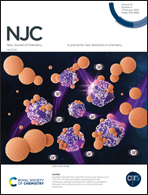A near-infrared fluorescent probe for detection of H2S and its application in monitoring meat freshness and plant growth under aluminium-induced stress†
Abstract
Hydrogen sulfide (H2S) has attracted increasing attention due to its multiple roles not only as an unpleasant gas released by spoiled food and toxic substances in industrial waste, but also as an important regulator of some physiological and pathological processes in animals and plants. Herein, we design and synthesize a near-infrared (NIR) fluorescent probe (CHO–OH–NO2) for turn-on detection of H2S. In this probe, an indole moiety serves as the electron acceptor, xanthene as the electron donor and an aldehyde/dinitrophenyl ether pair on xanthene as the recognition element for H2S detection. Triethylene glycol is attached onto the indole group for enhanced hydrophilicity and for easy loading onto test strips. This probe can specifically detect H2S with a relatively short response time of 30 min and high sensitivity with a limit of detection (LOD) of 0.75 μM. Test strips loaded with the probe has been employed to detect the real-time freshness of meats including prawn, beef and pork, and also to monitor Al3+-induced abiotic stress by detecting endogenous hydrogen sulfide in the early germination of wheat grains. This approach may provide a tool for developing test-strip-type H2S probes useable in the food industry and plant research.



 Please wait while we load your content...
Please wait while we load your content...